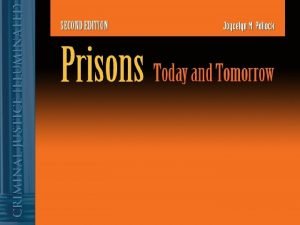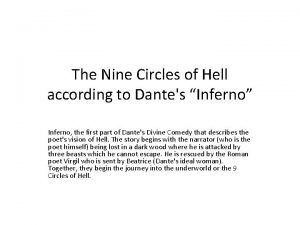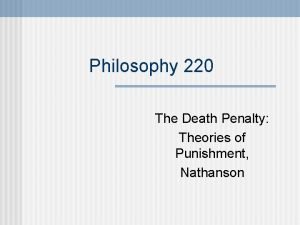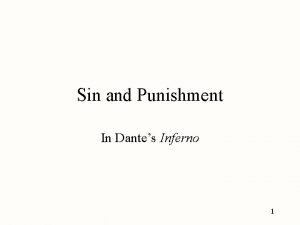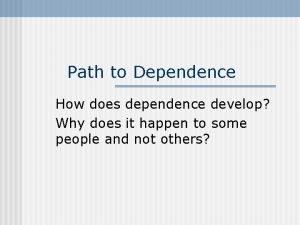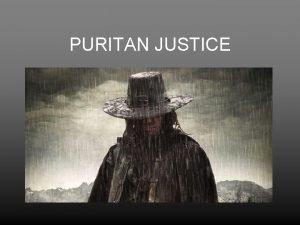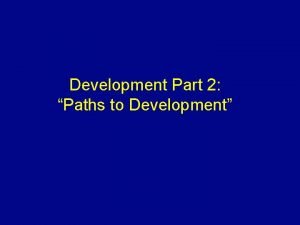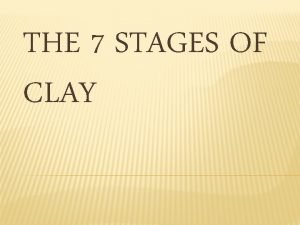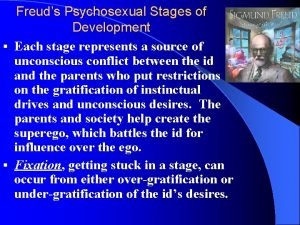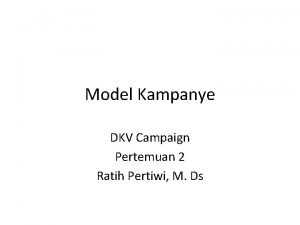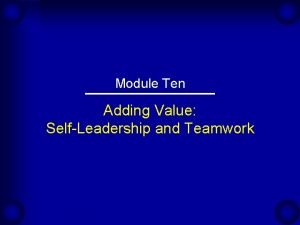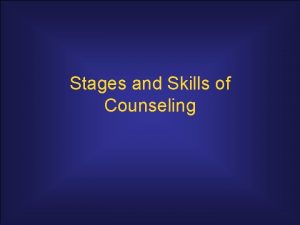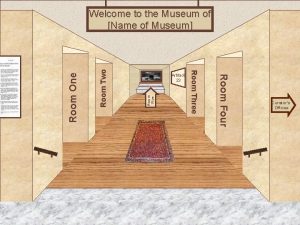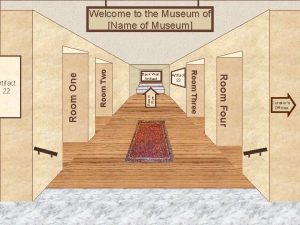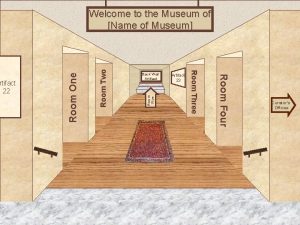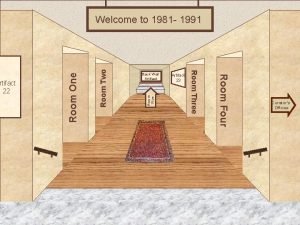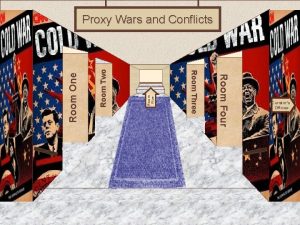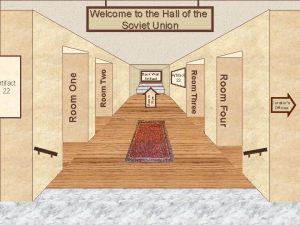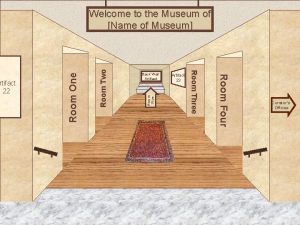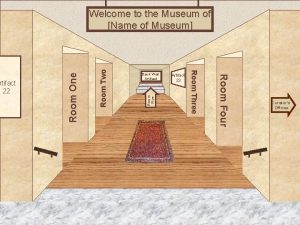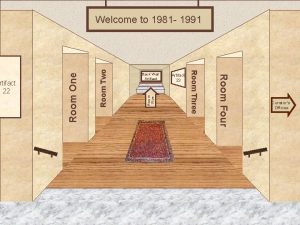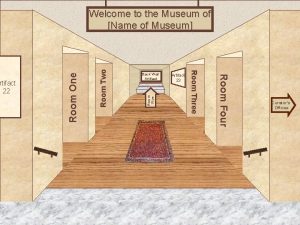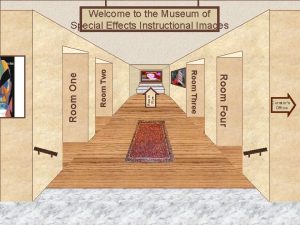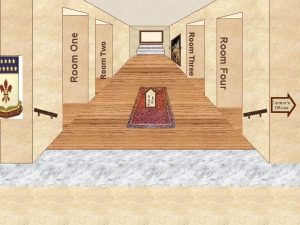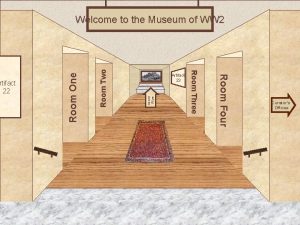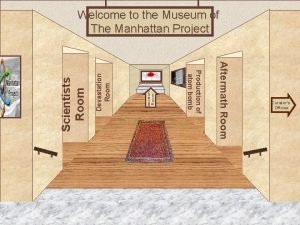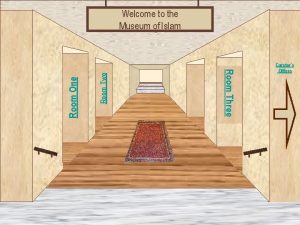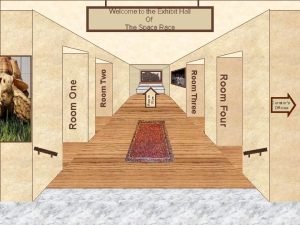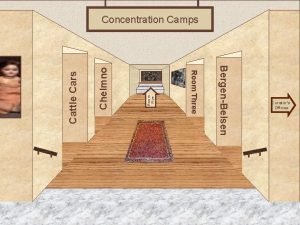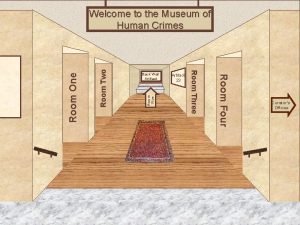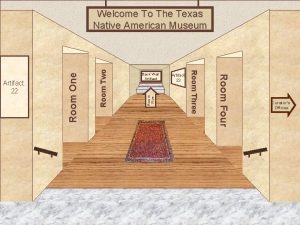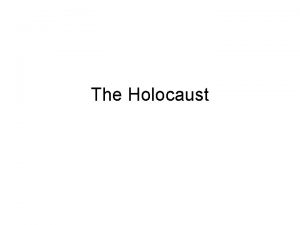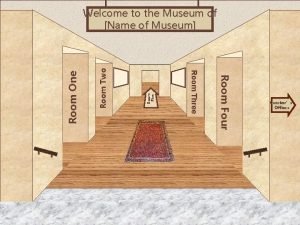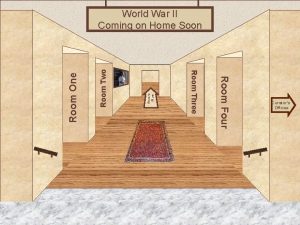Stages of Holocaust Room Five Museum Entrance Punishments
































- Slides: 32


Stages of Holocaust Room Five Museum Entrance Punishments End of the Holocaust Concentration Camps What is the Holocaust Welcome to the Museum of The Holocaust Curator’s Offices

Keonya’s Office Hi my name is Keonya Lee and I am the groups Curator for this museum. In my group I have Maria Maldonado and Maddie Roman. I am in period five and group five. I go to Kendyl Depoali Middle School. And I am 13 years old. I hope you enjoy the museum! keonyalee@icloud. com Return to Entry Note: Virtual museums were first introduced by educators at Keith Valley Middle School in Horsham, Pennsylvania. This template was designed by Dr. Christy Keeler. View the Educational Virtual Museums website for more information on this instructional technique.

What is the Holocaust Room 1 Return to Entry

Stages of the Holocaust Room 2 Return to Entry

Concentration Camps Room 3 Return to Entry

Punishments Room 4 Return to Entry

End of the Holocaust Room 5 Return to Entry

Clothing On arrival at concentration camps prisoners had their clothing taken away, often to be replaced by a striped uniform (now known as striped pajamas). Men would wear a vest, trousers, hat and coat. Women would be supplied a smock type dress. On their feet prisoners wore wooden or leather clogs. As socks were not supplied, clogs would rub on feet and ankles, causing foot sores. This could be very dangerous, as the conditions in barracks and around the camp were extremely poor. Prisoners could very easily get an infection, which could then lead to death. Clothes would be changed approximately every six weeks. As prisoners would have to work and sleep in the same clothes, they would be very dirty. Prisoners were identified by a number printed on their clothing and also an inverted triangle with lettering to signify the reason for imprisonment. Criminals were marked with a green triangle, political prisoners with red, homosexuals with pink, whilst Jehovah’s Witnesses wore a purple triangle and asocial (including Roma) wore a black triangle. In some camps, Jews were usually marked by a yellow triangle over a red triangle to form the Star of David. However, in others a yellow star identified them as being Jewish. Clothing Link Return to Exhibit

Star of David The Star of David -- known in Hebrew as "Magen David" -consists of two overlapping equilateral triangles that together form a hexagram, or six-pointed star. As part of their effort to isolate and persecute Jews, the Nazis forced Jewish citizens to identify themselves by wearing starshaped badges. Star Of David Link Return to Exhibit

Transportation Deportation and transportation to camps often took days. Individuals, families and whole communities together with their personal belongings were packed into cattle trucks. They were locked in and transported for days. They had no information. They did not know where they were going, the length of the journey or what would happen to them when they eventually arrived at their destination. The conditions on the journey were appalling. Transportation Link Return to Exhibit

Camps During the Holocaust, the Nazis established concentration camps across Europe. At first, these concentrations camps were meant to hold political prisoners; however, by the beginning of World War II, these concentration camps had transformed and expanded in order to house vast numbers of nonpolitical prisoners whom the Nazis exploited through forced labor. Many concentration camp prisoners died from the horrible living conditions or from being literally worked to death. Camps link Return to Exhibit

Definition Stage During the definition stage, the Jews were forced to wear the Star of David as identification and the Nazis put a “J” on every Jews passport so they could recognize a Jew if one tried to leave the country. There was little violence, only because the Nazis didn’t want to scare the Jews. They needed full cooperation. Definition link Return to Exhibit

Expropriation Stage During the Expropriation Stage, the Nuremburg laws were created so the Jewish people were denied equal rights. They were denied citizenship, prohibited from public office and denied marriage rights to non-Jews. Expropriation Link Return to Exhibit

Concentration Stage During the Concentration Stage, Jews were moved to the ghetto and were not allowed to play outside and they were kept inside fences. They were forced to share living spaces with many other people and were forced to give up all of their precious belongings. Later, Jews were taken on trains to concentration camps where a lot of people were separated from their families and killed. Concentration Link Return to Exhibit

Annihilation Stage During the Annihilation Stage, hundreds of Jews were killed in concentration camps. But Hitler was planning something called The Final Solution was where they planned on wiping out the remaining Jewish population in Europe by killing the Jews in larger amounts. They used mass shootings, gas chambers, and other things that would kill more Jews in a faster amount of time. Annhilation Link Return to Exhibit

Auschwitz-Birkenau Auschwitzs-Birkenau was one of the largest death camps across Europe. Historians estimated the number of deaths at Auschwitz's, there were about 2. 1 million to 4 million deaths and most of them were Jews and there death in the gas chambers. The word Auschwitz’s now a days has a meaning of terror, genocide, and The Holocaust. The Germans killed about 960, 000 out of the 1. 1 to 1. 3 million Jews deported to the Nazis concentration camps. Other victims includes 74, 000 Poles, 21, 000 Roma, 15, 000 Soviet prisoners of the war and at least about 10, 000 from other nationalities. “Work Set’s You Free” Holocaust Concentration Camps Photo Gallery Return to Exhibit

Berlin Marzhan “The Concentration Camp was one of the most notorious death camps of the Nazi regime, located just north of Berlin”. This camp was built in the summer of 1936, by prisoners from the Emsland camps and was used to train SS officers who went on to command other camps. In January 1945, there were more than 65, 000 prisoners here including 13, 000 women. A total of 105, 000 Jews died in this camp. Sachsenhausen-Oranienburg was liberated by the Allies on April 22 nd, 1945. The Soviets then used it as a prison camp until 1950 Berlin Link Return to Exhibit

Warsaw The Warsaw concentration camp was an associated group of the German Nazi concentration camps, including an extermination camp, located in Germanoccupied Warsaw, capital city of Poland. Its main target was the Polish population of the city. Immediately after Poland’s surrender in September 1939, the Jews of Warsaw were brutally preyed upon and taken forced labor. In 1939 the first anti -Jewish decrees were issued. The Jews were forced to wear a white armband with a blue Star of David and economic measures against them were taken that led to the unemployment of most of the city’s Jews. Warsaw Link Return to Exhibit

Dachau, the first Nazi concentration camp, opened in 1933, shortly after Adolf Hitler (1889 -1945) became chancellor of Germany. Located in southern Germany, Dachau initially housed political prisoners; however, it eventually evolved into a death camp where countless thousands of Jews died from malnutrition, disease and overwork or were executed. In addition to Jews, the camp’s prisoners included members of other groups Hitler considered unfit for the new Germany, including artists, intellectuals, the physically and mentally handicapped and homosexuals. With the advent of World War II (1939 -45), some able-bodied Dachau prisoners were used as slave labor to manufacture weapons and other materials for Germany’s war efforts. Additionally, some Dachau detainees were subjected to brutal medical experiments by the Nazis. U. S. military forces liberated Dachau in late April 1945. Camp Link Return to Exhibit

Gas Chambers The Nazis started their use of poison gas in 1939, as a tool for killing mentally and physically disabled patients in hospitals. They called this euthanasia, because they felt that these people were deemed to be unworthy of living, but it was essentially part of their systemic murder. There were six different killing centers throughout Nazi-occupied Europe that were established for this specific purpose. People were killed using chemically-created carbon monoxide or lethal injections. The gas seemed to be quicker and easier, though, so it was often the preferred option. Gas Chambers Link Return to Exhibit

Labor A WVHA decree of March 31, 1942 established a minimum working day of eleven hours in all concentration camps. At Auschwitz, labor was one of the means used to destroy prisoners. They labored in various sectors of the economy. Initially, they worked at building the camp: leveling the ground, erecting new blocks and buildings, laying roads, and digging drainage ditches. Later, the industries of the Third Reich made increasing use of cheap prisoner labor. The pace of the work, the starvation rations of food, and constant beatings and abuse exacerbated the death rate. The German IG Farbenindustrie cartel, which built the Buna-Werke synthetic rubber and fuel factory at Monowice near Oswiecim, had priority in obtaining prisoner labor. The majority of the Auschwitz sub-camps were located near the mills, mines, and factories of Silesia. Prisoners dug coal, produced armaments and chemicals, and built and expanded industrial plants. Labor Link Return to Exhibit

Executions were one means of physically liquidating prisoners and people brought from outside the camp. At first, people were shot to death in the pits near the camp from which gravel had been dug. From the autumn of 1941 until the autumn of 1943, most of the executions by shooting took place in the courtyard of Block No. 11 in the main camp. Most of the victims here were Poles, who received sentences of death by shooting from, for instance, the Gestapo summary court Executions Link Return to Exhibit

Starvation Prisoners in the camp received meals three times a day: morning, noon, and evening. Factors influencing the nutritional value of the food included the official nutritional norms in the Nazi concentration camps. In practice, Auschwitz prisoners with less physically demanding labor assignments received approximately 1, 300 calories per day, while those engaged in hard labor received approximately 1, 700. After several weeks on such starvation rations in the camp, most prisoners began to experience organic deterioration that led to the so-called "Muzulman" state, extreme physical exhaustion that ended in death. Starvation Link Return to Exhibit

Hitler Dead About 2: 30 in the morning of April 30, Hitler came out of his private quarters into a dining area for a farewell with staff members. With glazed eyes, he shook hands in silence, then retired back into his quarters. Following Hitler's departure, those officers and staff members mulled over the significance of what they had just witnessed. The tremendous tension of preceding days seemed to suddenly evaporate with the realization that the end of Hitler was near. A lighthearted mood surfaced, followed by spontaneous displays of merry-making even including dancing. At noon, Hitler attended his last military situation conference and was told the Soviets were just a block away. At 2 p. m. , Hitler sat down and had his last meal, a vegetarian lunch. His chauffeur was then ordered to deliver 200 liters of gasoline to the Chancellery garden. Hitler and his wife Eva then bid a final farewell to Bormann, Goebbels, Generals Krebs and Burgdorf, other remaining military aides and staff members. Hitler and his wife then went back into their private quarters while Bormann and Goebbels remained quietly nearby. Several moments later a gunshot was heard. After waiting a few moments, at 3: 30 p. m. , Bormann and Goebbels entered and found the body of Hitler sprawled on the sofa, dripping with blood from a gunshot to his right temple. Eva Braun had died from swallowing poison. As Soviet shells exploded nearby, the bodies were carried up to the Chancellery garden, doused with gasoline and burned while Bormann and Goebbels stood by and gave a Hitlers Death Link Return to Exhibit

Records After 1945 By May 1945, the Germans and their collaborators had murdered six million European Jews as part of a systematic plan of genocide—the Holocaust. When Allied troops entered the concentration camps, they discovered piles of corpses, bones, and human ashes—testimony to Nazi mass murder. Soldiers also found thousands of survivors—Jews and non-Jews—suffering from starvation and disease. For survivors, the prospect of rebuilding their lives was daunting. With few possibilities for emigration, tens of thousands of homeless Holocaust survivors were housed in displaced persons (DP) camps. In the following years, many international and domestic courts conducted trials of accused war criminals Records Link Return to Exhibit

Holocaust is over Camps were built for Jewish displaced persons, who couldn't return to their homes because of the horror and threats of danger from lingering anti-Semitic residents of the countries. They were emigrated to Israel, Palestine, and the United States primarily, while some went to other countries. These camps were in existence until 1957 when all the DPs (displaced persons) had been rehomed. When the Allied forces finally invaded Germany in 1945, Adolf Hitler knew he had been defeated. Whether out of cowardice and fear of punishment, or based on Nazi ideals of death before dishonor, Adolf Hitler committed suicide in April of 1945 before the Allies had a chance to capture him. Thousands of Nazis committed suicide during this year, as they were taught that it was a more favorable option than being captured and punished for their beliefs. However, hundreds more were caught and Holocaust End Date Link Return to Exhibit

What happens next ; Liberation As Allied troops moved across Europe in a series of offensives against Nazi Germany, they began to encounter tens of thousands of concentration camp prisoners. Many of these prisoners had survived forced marches into the interior of Germany from camps in occupied Poland. These prisoners were suffering from starvation and disease. Soviet forces were the first to approach a major Nazi camp, reaching Majdanek near Lublin, Poland, in July 1944. Surprised by the rapid Soviet advance, the Germans attempted to hide the evidence of mass murder by demolishing the camp. Camp staff set fire to the large crematorium used to burn bodies of murdered prisoners, but in the hasty evacuation the gas chambers were left standing. In the summer of 1944, the Soviets also overran the sites of the Belzec, Sobibor, and Treblinka killing centers. The Germans had dismantled these camps in 1943, after most of the Jews of Poland had already been killed. Liberation Link Return to Exhibit

Hitler Youth The Hitler Youth was the youth organization of the Nazi Party in Germany. Its origins dated back to 1922. From 1933 until 1945, it was the sole official youth organization in Germany and was partially a paramilitary organization; it was constituted of the Hitlerjugend proper for male youth aged 14 to 18, the Deutsches Jungvolk for younger boys, and the League of German Girls. Hitler Youth Return to Exhibit

Nazi Propaganda The Ministry's aim was to ensure that the Nazi message was successfully communicated through art, music, theater, films, books, radio, educational materials, and the press. There were several audiences for Nazi propaganda. Germans were reminded of the struggle against foreign enemies and Jewish subversion. During periods preceding legislation or executive measures against Jews, propaganda campaigns created an atmosphere tolerant of violence against Jews, particularly in 1935 (before the Nuremberg Race Laws of September) and in 1938 (prior to the barrage of antisemitic economic legislation following Kristallnacht). Propaganda also encouraged passivity and acceptance of the impending measures against Jews, as these appeared to depict the Nazi government as stepping in and “restoring order. ” Nazi Propaganda Return to Entrance

Work Will Set You Free. "Arbeit macht frei" is a German phrase meaning "work makes (you) free. “ The slogan was placed over the entrances to a number of Nazi concentration camps during World War II, including Auschwitz, where it was made by prisoners with metalwork skills and erected by order of the Nazis in June 1940. Work Will Set You Free Link Return to Entrance

End of the war These included the massacre of millions of Chinese and Korean nationals by Japan, internal mass killings in the Soviet Union, and the bombing of civilian targets in German and Japanese cities by the Allies. In total, World War II produced about 50 million deaths, more than any other war to date. End of War Link Return to Exhibit
 Let's look at some examples
Let's look at some examples Victorian school punishments
Victorian school punishments Domestic discipline contracts
Domestic discipline contracts Target person
Target person Nnn punishments
Nnn punishments Nine circle of hell
Nine circle of hell Death penalty philosophy
Death penalty philosophy Good nnn punishments
Good nnn punishments Inferno punishments
Inferno punishments Nnn punishments
Nnn punishments Education in victorian england
Education in victorian england Puritanical methods of punishment
Puritanical methods of punishment Discipline without stress punishments or rewards
Discipline without stress punishments or rewards School punishments in the 1950s
School punishments in the 1950s Doris lessing to room nineteen analysis
Doris lessing to room nineteen analysis Living room bedroom kitchen bathroom
Living room bedroom kitchen bathroom Hotel database sql queries
Hotel database sql queries What are the five stages of psychosexual development
What are the five stages of psychosexual development What is writing process in business communication
What is writing process in business communication Freud psychosexual stages mnemonic
Freud psychosexual stages mnemonic Morton's resolution model
Morton's resolution model 5 stages of plot diagram
5 stages of plot diagram What is development
What is development Linear stage theory
Linear stage theory Stages of clay drying
Stages of clay drying Fixation of anal stage
Fixation of anal stage What are the three stages of the writing process
What are the three stages of the writing process Model kampanye komponensial
Model kampanye komponensial Itil service lifecycle stages
Itil service lifecycle stages Five sequential stages of self-leadership
Five sequential stages of self-leadership Peak stage of fashion cycle
Peak stage of fashion cycle Freud's five stages of psychosexual development
Freud's five stages of psychosexual development Structure of counselling process
Structure of counselling process




